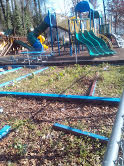
Guest Writer: Maryam Funmilayo
Spring will be here in the next few months, and it is time to get ready for a family gardening project. I am so excited because it will be my very first time getting serious about gardening. More so, my children have always been curious about how seeds germinate, flowers evolve, vegetables develop, and how they are picked and prepared to become the food we eat. The good thing is that there is no need to re-invent the wheel by starting from scratch. Thanks to an Outreach and Engagement Seed Grant from the NC State Office of Extension, Engagement, and Economic Development, the IAR Women’s Committee is working with Dr. Dara Bloom and Dr. Annie Hardison-Moody to expand and enhance the Al-Iman School garden, which serves as both a school and community garden. It is situated on the Islamic Association of Raleigh’s premises.
 This family gardening project is an excellent project for the entire community. It is a unique opportunity to spend good time with one another. Also, this will encourage children to question natural events that occur during planting and harvesting. I am very happy that the IAR community members have shown enormous interest in this project and are ready to volunteer their time on working on the garden. Homeschooling families, who are always looking for outdoor opportunities, have also shown great interest in volunteering.
This family gardening project is an excellent project for the entire community. It is a unique opportunity to spend good time with one another. Also, this will encourage children to question natural events that occur during planting and harvesting. I am very happy that the IAR community members have shown enormous interest in this project and are ready to volunteer their time on working on the garden. Homeschooling families, who are always looking for outdoor opportunities, have also shown great interest in volunteering.
Here are some tips I would like to share as you embark on your family gardening project:
- Have the intention that you want to contribute to environmental sustainability and revive and support agricultural life.
- Start the garden (if it is new) at the right time. This is very important to the success of the project. This is an advice that was shared with IAR community members by NC Cooperative Extension Master Gardeners.
- Select a site and draw out a garden plan. This will guarantee maximum productivity and allow each plan room to grow very well.
- Measure the dimensions of the garden plot and seek for professional advice from Master Gardeners.
- Make sure the soil has been well prepared and avoid planting too early, too close together, or too deep. In addition, watering too little or too much can be harmful to the plants.
- During this time of the year and in early spring, it is advised to plant onions, lettuce, radishes, peas, cabbage, potatoes, and a whole world of greens. These particular vegetables do take some frost and cold temperatures without many problems.
Okay, this is it for now. In part 2, I will mention other vegetables as well as fruits and herbs that can be planted for a family gardening project. I have been reading on companion planting and it is amazing how different kinds of plants can benefit one another just like humans do. I hope to share some tips with you on companion planting in part 2. In part 3, I will mention some key health benefits that you can get from your garden, be it a home garden, school, or community garden. And in the final series, part 4, I will write about organizations that that are involved in giving free monetary grants for new or existing gardens.
Stay tuned!
